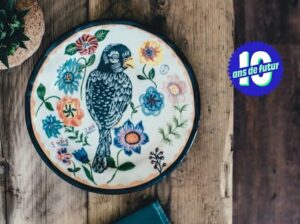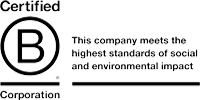Ecotone has teamed up with French leading prospective magazine Usbek & Rica to launch a series of articles on food and biodiversity, present, past… and future!
Read below the article (French version available on the Magazine’s website)
“Choosing your food means choosing the biodiversity you want”
After the war, intensive agriculture standardised our agricultural landscapes. Using fertilisers and pesticides has devastated the plant and animal species in our countryside. Now, we’re reintroducing it fork by fork, as we overhaul the contents of our plates. Anne Meyer is a divisions manager and agro-economist at Ecotone (Bjorg, Alter Eco, Clipper, etc.) and “sustains biodiversity”. Philippe Pointereau, director of the agri-environment division at Solagro, studies biodiversity “from the field to the plate”. For a more in-depth look at the thought process initiated on this theme in the 10th anniversary edition of Usbek & Rica, both of them talk to us about the past, present and future of our food production approach.
Why are the subjects of food and biodiversity so closely linked?
Philippe Pointreau
What we eat comes from agricultural land, except for sea-based products. Our food therefore involves a certain use of land, a certain number of occupied hectares and a certain way of cultivating them. These choices have positive or negative impacts on biodiversity and more globally on our natural resources and climate. Already, as the population grows, with food demands that grow with it, the pressure on agricultural land is increasing. We’re seeing deforestation in order to create more agricultural land in places like South America, Africa, Indonesia and Malaysia, while in Northern Europe, forest is actually regaining ground.
The choice of crop and production methods determine irrigation, the use of pesticides and the use of chemical fertilisers, all of which have an impact on nature and living organisms. Today, all scientific studies show that biodiversity is collapsing in the agricultural arena.
Choosing your food means choosing the biodiversity you want. If you choose organic food, you’re choosing less intensive agriculture, and that doesn’t use chemical phytosanitary products. If you opt for a meat-based diet, space can be freed up for example, and grass-fed ruminant farms can be favoured that can do without GMO soy and corn silage, crops that have a high impact on the environment.
Anne Meyer
Everyone knows now that there can’t be farming without biodiversity, i.e. without soil diversity, without pollination, and without all the ecosystem services provided by nature and living things. But I also like to say – and not everyone as readily agrees on this – that there can be no biodiversity without agriculture. A whole bunch of ecosystems depend on farming. Of course, not the kind of farming where the synthetic ingredients are scattered on the winds. But there are lots of plant and animal species that depend on farming when it is done responsibly.
Today, the farming world sometimes exploits Nature rather than working with it… how did it used to work before the industrial revolution?
Philippe Pointreau
Until the 1950s, the farming models used by European countries were based on Nature and developed with it. There was an idea that if you harmed it too much, you wouldn’t get to enjoy its resources any more. After the war, Europe had very diverse agriculture with livestock distributed around the land in small fields with hedges and woodland, and very few agricultural inputs with high natural value being maintained. There were more famers, and it was common for people to produce their own food in their gardens and backyards.
Anne Meyer
But we mustn’t idealise the farms of the pre-industrial era, however. Farming life at the start of the 20th century was harsh because, apart from in the summer, farmers would produce almost exclusively potatoes and cabbages, and they’d kill a pig once a year. This kind of farming wouldn’t have been enough when the demographical challenges of supplying the baby boom came along in the 1940s-1950s. After that, it’s hard to say if it was the growth in population that increased farming, or the opposite.
What changed from the 1950s and 1960s onwards?
Anne Meyer
It was the impetus towards specialisation that we began to see in the industrial world that changed farming in the ’50s. The traditional self-sufficient farm turned into a farm dedicated to pig rearing or growing beets, and this specialisation made farms much more dependent on agricultural inputs, whether they were synthetic or not. Farmers had to look elsewhere for what their farms didn’t produce themselves…
Philippe Pointreau
And we know what happened next: mechanisation and the mass use of inputs started to become widespread. The high cereal yields led to increased livestock breeding, and therefore meat was produced to sustain production. We moved towards a system with high impact on biodiversity. We also went international; before, our food came from a nearby place of production, whereas today, the number one fish eaten in France is salmon bred in Norway and partially fed on South American GMO soya in a process using antibiotics.
Exactly, so what does a typical meal look like today?
Philippe Pointreau
In France, meat has taken a central place in our meals, topped off by a starter or a soup, cheese, salad, a dessert, etc. Only here can we afford this. It’s different in Asia for example, where meat isn’t central and is only served on high days and holidays.
What has also changed is the globalisation of our food. We eat lots of imported products, including some that could be produced in France, like vegetables. We don’t talk enough about the consequences of our imports. We shouldn’t be justifying things on the scale of French agriculture but on the scale of the global footprint our food creates. When you do that, you can really see how our predation on the planet is taking on ever-increasing proportions.
Anne Meyer
Out of the thousands of existing plant species, only nine species make up two thirds of our meals – corn, soybeans, rice, potatoes, wheat, palm oil, cane sugar, beet sugar, and cassava. France is also lagging behind in terms of organic food: in France, organic food represents 6% of overall food consumption, compared to 10% in Germany. But we see signs that make us hopeful however. We’re seeking what we’ve lost, and we are indeed seeing people eating less meat and opting for a plant-based, organic diet.
In the current context of climate change, farming, and especially organic farming, is a very effective lever for change…
Philippe Pointreau
Sustainable farming is back on the table, after being neglected for a long time. We’re now seeing a growing commitment in local authorities, municipalities, metropolises and regions who are relocating some of the food chain and promoting virtuous production methods. Consumers are also on the alert because their demands and preference for organic food is forcing companies to change.
At Solagro, we strongly believe that the food lever is central for environmental change, and we always strive to demonstrate this. Everyone has control over their food; by choosing to buy this or that product, in this or that season and in this or that place, everyone can have an impact.
Today, everything’s ready to activate this lever because the food of future exists already, the farms to produce it as well. Consumers are also already there, and companies are becoming more and more committed to this transition towards more plant-based, organic food. The future is already here, only it is still in the minority. What we need currently is the political will to activate this lever collectively on a mass scale.
What direction do you think farming should take?
Anne Meyer
Everybody has already agreed about the importance of shifting to more sustainable farming, but not everyone agrees on how to do it. The debates focus on the opposition between land sparing (areas of intensive agricultural production on one side and areas of biodiversity without any cultivation on the other) and land sharing (extensive stretches of farmland where biodiversity is promoted).
Obviously, the land sparing concept doesn’t work because it doesn’t account for the natural resources that are pumped into nature for free, nor the pollution that is poured into it without bearing the consequences. We have to get our heads round the fact that it makes no sense to pollute the land more in one place so we can produce more and then leave everything to nature somewhere else.
Philippe Pointreau
Land sparing is not the solution in France. The intensification of agricultural practices such as irrigating corn is threatening the safety of our drinking water with its herbicides. Biodiversity needs to be maintained in the fields to favour biological controls and pollination. Planting hedges and cover crops helps prevent soil erosion. We have no choice but to opt for land sharing in order to restore biodiversity, which doesn’t stop us from allocating more zones to creating nature reserves with no or very little farming.
What should our future meals look like according to you?
Philippe Pointreau
Our scenarios show that we need more plant-based and organic products. So we have to reduce our consumption of dairy products, meat and fish. That being said, it doesn’t mean removing meat completely, it’s just more about preserving virtuous breeding systems and removing intensive breeding systems for poulty, pigs, and dairy cows that are mainly fed with silage and soya. France’s biggest challenge is deploying fruit and vegetable production on a large scale. It has been calculated that we need to plant over 600,000 hectares of fruit and vegetables even though this produce is currently on the decline in our country. Better yet, they need to be produced organically. So we need more farmers trained in the challenges of biodiversity and who are more in control of their production and sowing.
Anne Meyer
Meat and fish will no longer be central to our diets. But they will still have a place. Ecotone produces 97% plant-based food and for the remaining 3% we’re looking for virtuous breeders. This is vital because 100% organically farmed plant-based food can’t exist without a small percentage of organically bred animals to fertilise the fields growing all these plant-based products. What is needed are livestock farms that are complementary to farm-scale crop production. The problem is that we want to keep producing cheap food at any cost, even though this food always ends up costing more for the person eating it, mostly through social security. Our future food will be food produced by farming that knows how to pair goats with cabbages…!







